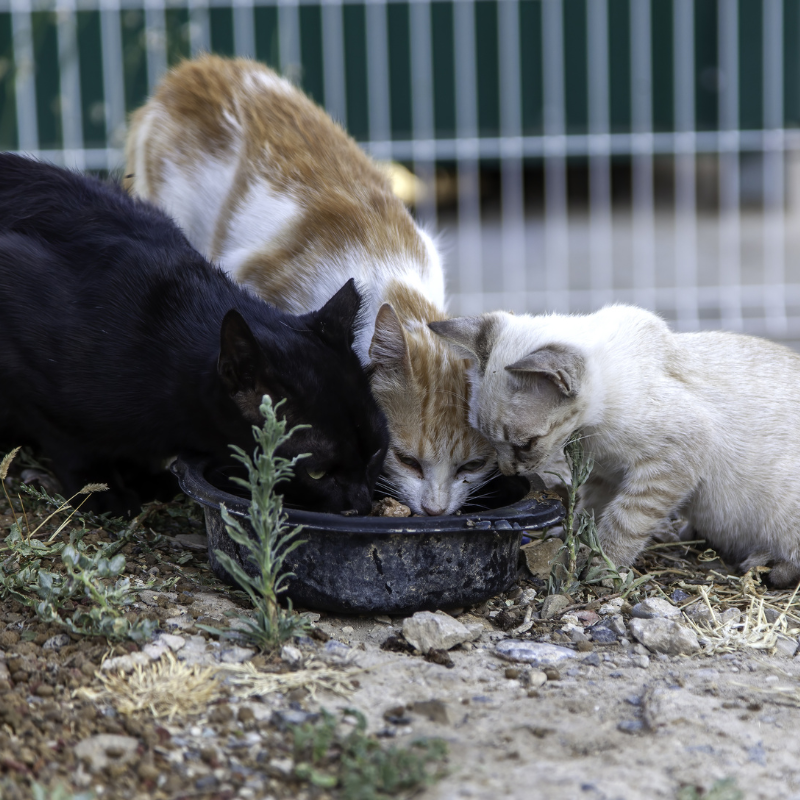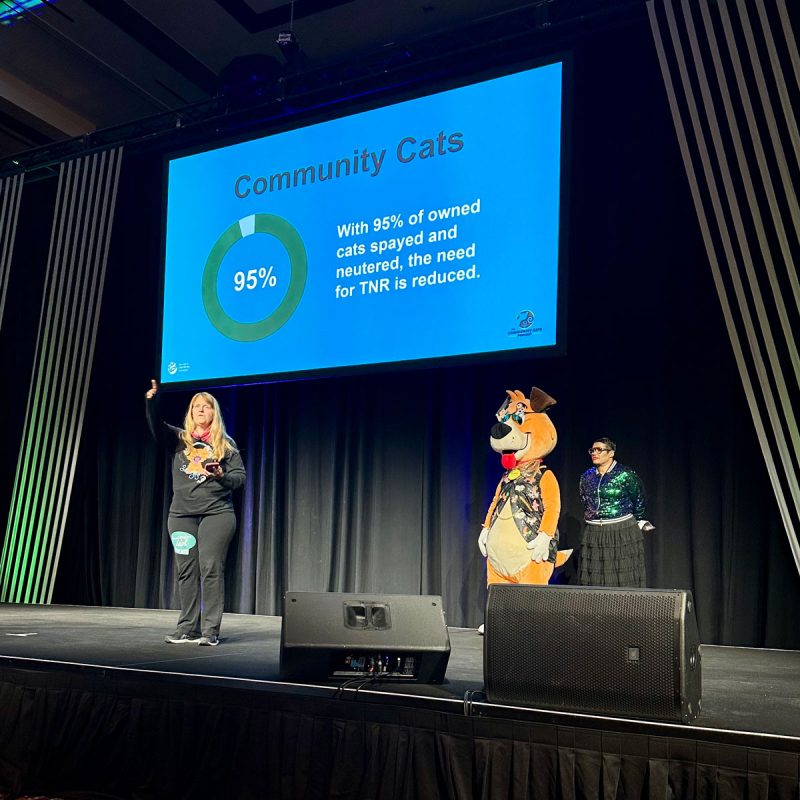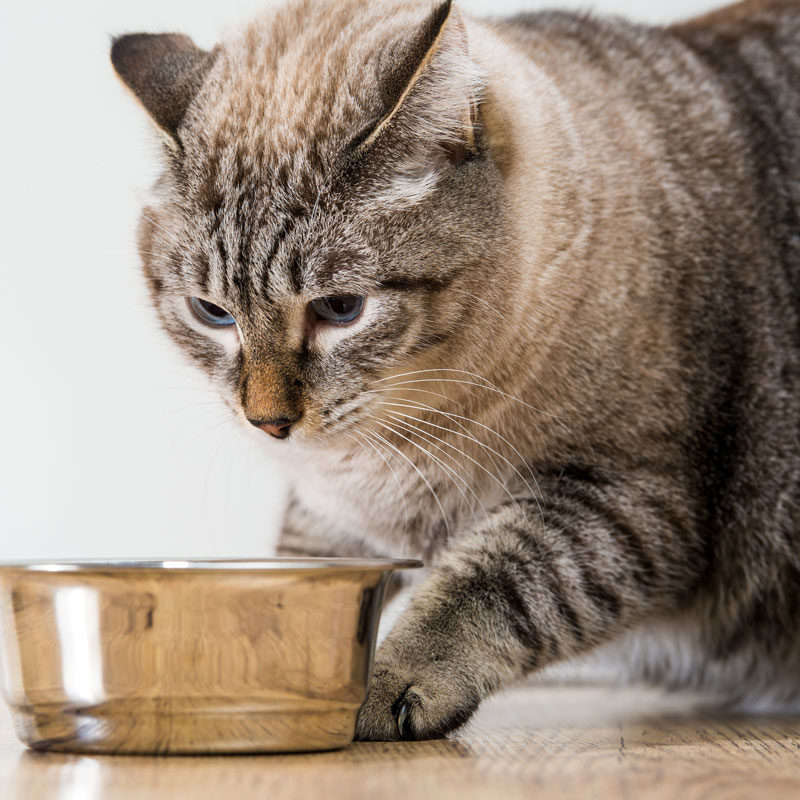
Creating Community Connections with TNR Advocacy and Cat-Friendly Business Models
February 4, 2025
The Science Behind FIP: Every Cat Health Foundation’s Mission to Save Lives
February 11, 2025
Learn the best protocols for community cat care, including feeding, watering, disease prevention, and tips for managing a healthy colony with minimal waste.
Caring for community cat colonies is a rewarding but long-term responsibility. Whether you’re new to colony caretaking or managing an established group, these best practices will help you ensure their health and happiness.
Feeding Tips for Colony Caretakers
Alley Cat Allies recommends a few different practices all designed to help you keep your colony happy and healthy, keep your space clean, and reduce food waste.
- Key Feeding Practices for Feral Cats:
- Feed at the same time every day.
- Remove uneaten food after 30 minutes.
- Use feeding stations to protect food from wildlife.
Feed community cats safely during daylight hours, in the same place and at the same time every day. After 30 minutes, remove any uneaten food. You can adjust the amount of food you’re leaving out if all is gone after 15 minutes or if much is still left after 30. Though it may be tempting to put out food and leave it or to feed directly on the ground, we do not recommend either of those practices. Leaving out extra food that the cats aren’t eating will attract other critters, bringing local wildlife into conflict with your colony. Don’t try to manage the order in which the cats feed; they will work this out on their own.
Instead of ground feeding, use a feeding station that is hidden from the public, protected from the elements, away from high traffic areas, and not too close to where the cats sleep or go to the bathroom. This will help you create a routine for the cats: they’ll always know where they can expect to find food every day, which also means it will be a good spot for you to trap when you need to do TNR. Keep your feeding stations clean, making sure to properly dispose of any disposable dishes if you use them.
If you are having problems with insects, there are a few different strategies for mitigating them. The most effective of course is not leaving food out for longer than 30 minutes and making sure the whole colony site stays as tidy as possible. But if you are still having problems with insects, you can create a moat around feeding bowls by placing the bowls in a tray, create a circle around the bowls with food-grade diatomaceous earth or baking soda, or rubbing the outside of bowls with cooking oil.
Alley Cat Allies has a lot of good resources for different types of feeding stations, so check them out.
Wet Food vs. Dry Food: Pros and Cons
Dry food can be left out all day without spoiling, but could attract other animals—feed during the day and just during your 30 minute feeding period to limit this. If you are unable to stay for 30 minutes during feeding for your colony, make sure to return each evening to tidy up. Leaving out food overnight will also attract more critters. Alley Cat Allies recommends never to leave food out longer than 30 min even if it’s dry food.
Wet food shouldn’t be left out, so if feeding wet food, you should stay and monitor and then pick up dishes and whatever is not eaten after 30 min. It’s up to you whether you feed both dry and wet or just dry. On average, adult feral cats eat 5.5 ounces of wet food and 2 ounces of dry food daily, though you should feed more in winter. If you live somewhere wet food will freeze in the winter, just do dry food in the winter.
While wet food ensures proper hydration, dry food is more practical for long-term feeding with minimal cleanup. Choose based on your colony’s needs and the season.
What resources are there for providing food for your colony?
Contact your local humane society or human food bank to see if they have surplus food, or consider reaching out to vet clinics or food supply stores for just out of date food they would otherwise discard.
Providing Fresh Water to Community Cats
Fresh water should always be available for the colony. If cats aren’t drinking what you provide, try moving the water a little distance from the food.
How to Prevent Water From Freezing for Outdoor Cats
In the winter, wider, deeper bowls can help keep water from freezing. Use dark colored bowls and place them in a sunny spot. You can refill with warm water and add a pinch of sugar to slow freezing. There are a few more high tech solutions to freezing water bowls as well: heated bowls (if you have access to an outlet), solar powered bowls, insulated bowls, and microwavable disks that sit under the bowls.
Neighborliness: Keeping Good Relations in Your Community
It’s important for community cat caretakers to be good neighbors. We can do our best and most important work only with the goodwill of the community. So don’t feed on property that isn’t yours without permission. If your colony is in a public place like a campus or a workplace, work with the onsite maintenance team. Do your best to keep the site as clean, tidy, and unobtrusive as possible.
Gaining community support is crucial for successful colony caretaking and helps avoid conflicts with neighbors or property owners.
Why Tortillas Are Not a Good Feeding Solution
Using tortillas instead of plates might seem eco-friendly, but it can attract pests, harm wildlife, and disrupt colony safety.
Some colony caretakers suggest using a flour tortilla instead of a plate for feeding cats. The rationale behind this is that since the tortilla is edible too, caretakers will be able to leave the food on the tortilla, the cats will eat, and then the tortilla will either decompose on its own or be eaten by something else. No waste right?
Well, not really.
Will the tortilla decompose? Eventually, sure. It will take a tortilla several months to decompose in a compost pile, longer if it’s just sitting on the ground.
But the bigger problem here is that the tortilla will attract other animals to your colony like birds, insects, and critters like raccoons, opossums, and even bears. These animals can bring diseases and potentially other conflicts to your colony, not to mention that wildlife shouldn’t be eating human food. Wild animals that are fed by humans lose the ability to find food on their own, making them dependent on you. Flour tortillas—and human food in general—is also bad for most critters, especially birds, who shouldn’t eat flour-based foods. In fact though they can eat small amounts of flour or corn tortillas, cats shouldn’t eat them regularly either.
So what should you do instead?
Follow best practices for colony caretaking and feed for 30 minutes—on disposable or reusable plates—then remove the food bowls or plates along with any uneaten food. This eliminates the problem of trash being left behind and will mitigate the attraction of insects and other critters.
Remember being a good colony caretaker is also being a good neighbor. Always follow Leave No Trace principles and dispose of waste properly, respect wildlife, and be considerate of others. We owe it to everyone who shares our community—humans, community cats, and wildlife.
Preventing Chronic Diseases in Community Cats
Preventing chronic illness in community cats starts with proactive care: spaying/neutering, vaccination, and maintaining clean shelters and feeding areas.
Community cats are hardy. According to a study in New Zealand, managed community cats can be comparable to companion cats in terms of health and welfare. But there are a few things colony caretakers can do to prevent chronic disease in community cats.
- Spay or Neuter and Vaccination
Of course, the most important tool in preventing chronic disease in community cats is making sure all cats in the colony are spayed or neutered and up to date on their vaccines. Spaying and neutering prevents the colony from growing, but also reduces territorial behavior, lowers risk of cancer, and prevents illness. Vaccines and flea, mite, and tick prevention are also important. - Maintaining Healthy Diets
Another way to prevent chronic illness is to make sure cats have a good diet. If multiple caretakers are working with the same colony, know who is feeding and what they are feeding. Make sure you’re feeding regularly on clean plates and providing fresh water. Feeding dry food can also help with dental care. - Shelter and Bathroom Solution
Building shelters for cats to get out of the weather is another way to keep community cats healthy. There are a variety of DIYshelters and shelters available for purchase that you can set up in your colony. It’s also a good idea to set up an outdoor litter box and scoop regularly. This will help mitigate cats contracting toxoplasmosis and will help keep cats from eliminating in community members’ flower beds or lawns. - Tracking your Colony’s Health
Keep a good record of which cats are part of the colony, what their spay/neuter and vaccine status is, and what their normal habits are. That way, when something out of the ordinary happens, you notice. Alley Cat Allies has a good template for colony tracking and recording caregiver information. This is also helpful if a new cat joins the colony. If a new healthy, friendly cat joins the colony, try the paper collar method to determine if the cat is already being cared for by someone. Download the paper collar here.
Want to become certified in TNR solutions? Check out our educational opportunities!
 This article was contributed by Krista Beucler • Originally from Colorado, Krista Beucler received a Bachelor of Arts in creative writing at the University of Mary Washington in Virginia. Krista is currently pursuing an MFA in creative writing from Drexel University. Krista has been published in various literary magazines and received certificates of excellence from the Cat Writers Association.
This article was contributed by Krista Beucler • Originally from Colorado, Krista Beucler received a Bachelor of Arts in creative writing at the University of Mary Washington in Virginia. Krista is currently pursuing an MFA in creative writing from Drexel University. Krista has been published in various literary magazines and received certificates of excellence from the Cat Writers Association.




